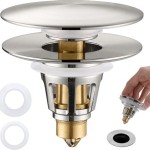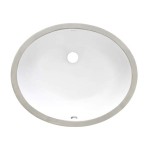Bathroom Vanity Without Sink Top: A Comprehensive Guide
The bathroom vanity serves as a cornerstone of bathroom design, providing both functional storage and aesthetic appeal. While many vanities are sold with pre-installed sink tops, a growing segment of the market focuses on bathroom vanities without sink tops. These units offer considerable flexibility and customization options for homeowners and designers seeking to create a unique and personalized bathroom space. This article will explore the benefits, considerations, and key aspects of choosing a bathroom vanity without a sink top.
Understanding the Benefits of a Vanity Without a Sink Top
Selecting a bathroom vanity without a sink top offers several advantages over purchasing a complete vanity unit. These advantages relate to customization, material choices, budget control, and design flexibility.
Firstly, the primary benefit lies in the enhanced customization possibilities. Purchasing a vanity cabinet separately from the sink top allows homeowners to precisely match the cabinet style and finish to their desired aesthetic. It allows for the freedom to combine different design elements and achieve a truly personalized look. This is particularly useful when trying to match existing bathroom fixtures or achieve a specific thematic style, such as modern farmhouse or minimalist contemporary.
Secondly, a broader range of material options becomes available. Pre-fabricated vanities often limit the choices for both the cabinet material and the sink top material. Opting for a separate vanity base and sink top expands the selection to include various woods, metal accents, and construction styles for the cabinet, as well as a wider array of countertop materials such as granite, marble, quartz, concrete, solid surface materials, and even custom-made wood or epoxy resin tops. This freedom allows for the selection of higher-quality materials or the possibility to select more budget-friendly options within each component.
Thirdly, budget control can be more effectively managed. By purchasing the vanity cabinet and sink top separately, consumers can allocate their budget according to their priorities. For example, a homeowner may choose to invest in a high-quality, durable vanity cabinet and opt for a more affordable sink top material, or vice versa. This granular control over spending can be particularly beneficial for large-scale bathroom renovations or remodeling projects with a strict budget.
Finally, design flexibility is significantly increased. The freedom to choose different styles, sink sizes, and mounting options opens up a wide array of design possibilities. Undermount, vessel, and drop-in sinks can all be readily accommodated, allowing for unique visual effects and practical considerations. The vanity can also be selected to specifically accommodate plumbing locations and space constraints, offering a more tailored solution compared to a pre-assembled unit.
Key Considerations When Choosing a Vanity Without a Sink Top
Selecting a bathroom vanity without a sink top requires careful consideration of several factors to ensure compatibility, functionality, and aesthetic coherence. These considerations include size and dimensions, material compatibility, sink type and mounting, plumbing requirements, and overall style consistency.
The size and dimensions of the vanity cabinet are paramount. Accurate measurements of the available bathroom space are crucial to ensure the chosen vanity fits comfortably without obstructing movement or interfering with other fixtures. The height, width, and depth of the vanity must be carefully considered, taking into account any existing plumbing locations or architectural features. Consider the storage capacity needed based on the size and layout of the vanity.
Material compatibility is another critical aspect. The material of the vanity cabinet and the sink top should complement each other aesthetically and functionally. For example, a solid wood vanity cabinet may pair well with a granite or marble top, while a more modern cabinet with metal accents may be better suited to a quartz or concrete countertop. The materials should also be durable and suitable for the humid environment of a bathroom. Water resistance and ease of cleaning are key factors to consider. Choose materials that are resistant to mold and mildew growth.
The type of sink and its mounting method are closely linked to the choice of vanity. The vanity cabinet must be designed or adapted to accommodate the chosen sink type, whether it is an undermount, vessel, drop-in, or wall-mounted sink. Undermount sinks require a solid countertop material, such as granite or quartz, which can be properly sealed to prevent water damage. Vessel sinks sit on top of the countertop, requiring a vanity with a flat surface and appropriate faucet placement. Drop-in sinks require a cutout in the countertop to fit the sink basin. Wall-mounted sinks, although not directly attached to the vanity, influence the vanity's overall aesthetic and functionality.
Plumbing requirements are a significant factor. The vanity cabinet must be designed to accommodate existing plumbing locations for water supply and drainage. Ensure there is sufficient space within the vanity to conceal the plumbing lines and provide access for maintenance. If necessary, modifications to the plumbing may be required to align with the chosen vanity and sink configuration. It's often advisable to consult with a plumber during the planning phase to ensure compatibility and address any potential challenges.
Finally, maintaining overall style consistency is crucial for creating a cohesive and aesthetically pleasing bathroom design. The style of the vanity cabinet, sink top, faucet, and other bathroom fixtures should complement each other and align with the desired overall aesthetic. Consider the color palette, materials, and design details to ensure a harmonious and coordinated look. Create mood boards and visual references to assess the compatibility of different elements and make informed decisions.
Exploring Design and Style Options
The ability to mix and match different components allows for a vast range of design and style options when selecting a bathroom vanity without a sink top. This freedom allows homeowners to create spaces that are both functional and visually stunning.
Modern and contemporary styles often feature clean lines, minimalist designs, and a focus on functionality. Vanity cabinets in this style may be made from materials such as engineered wood, metal, or glass. Countertops can be crafted from quartz, concrete, or solid surface materials. Vessel sinks or undermount sinks with sleek faucets are commonly used to complete the look. Geometric shapes and neutral color palettes are often employed to create a sense of calm and sophistication. The emphasis is on simplicity and functionality.
Traditional and classic styles evoke a sense of elegance and timelessness. Vanity cabinets in this style are typically made from solid wood, often with intricate carvings or moldings. Countertops may be made from granite, marble, or other natural stone materials. Drop-in or undermount sinks with ornate faucets are often used. Warm color palettes, antique brass hardware, and decorative accents are common features. The focus is on creating a luxurious and refined atmosphere.
Farmhouse and rustic styles embrace natural materials and a relaxed, informal aesthetic. Vanity cabinets may be made from reclaimed wood or distressed finishes, often with visible wood grain and knots. Countertops can be made from wood, concrete, or even repurposed materials such as butcher block. Farmhouse sinks with apron fronts are a popular choice. Natural color palettes, exposed hardware, and vintage-inspired accessories are common. The aim is to create a warm, inviting, and comfortable space.
Eclectic styles allow for a mix-and-match approach, combining elements from different design periods and styles. This approach requires a keen eye for balance and harmony to create a cohesive and visually appealing look. Vanity cabinets can be chosen from a wide range of materials and styles, and countertops can be made from any material that complements the overall design. The key is to find common threads that tie the different elements together, such as color, texture, or pattern. Eclectic styles allow for personal expression and creativity.
The choice of a bathroom vanity without a sink top empowers homeowners and designers with unparalleled control over the appearance and functionality of the bathroom. By carefully considering the benefits, key considerations, and design options, it is possible to create a bespoke bathroom space that reflects individual tastes and needs.

Vanities Without Tops Bathroom Luxury Living Direct

Alaterre Furniture Williamsburg 48 In W X 21 D 34 H Bath Vanity Cabinet Without Top White Avan48whbb The Home

The Campbell 59 Four Drawer Bathroom Vanity Without Top

Design House 597229 Wyndham 36 Inch Unassembled 1 Door 2 Drawer Bathroom Vanity Without Top White Wal Com

Upiker Modern 18 In W X 30 D 20 5 H Wall Hung Bath Vanity Cabinet Without Top Light Oak Up2208bcl30002 The Home

36 In Bathroom Vanities Without Tops At Com

Design House 597278 Wyndham Unassembled 2 Door 4 Drawer Bathroom Vanity Without Top 48 White Wal Com

72 Inch Double Sink Bathroom Vanity With Choice Of No Top

Magic Home 30 In W X 18 D 33 5 H Bath Vanity Cabinet Without Top Gray Zg 8003bn The

Design House 587030 Concord 2 Door 4 Drawer Bathroom Vanity Without Top Unassembled 60x21 White Wal Com







